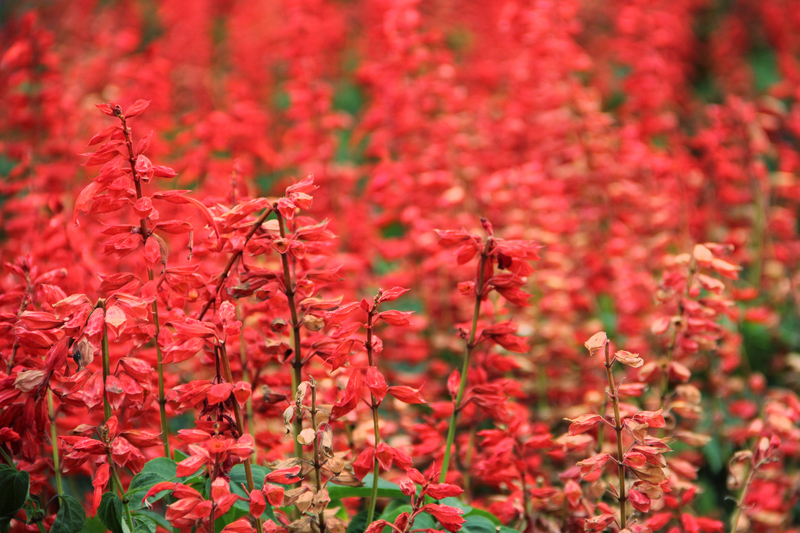Revitalize and Rejuvenate: Tips for a Neglected Garden
Posted on 26/08/2025
Revitalize and Rejuvenate: Tips for a Neglected Garden
Is your backyard more jungle than sanctuary? Turn things around! If you've inherited or simply let your garden fall to the wayside, don't worry -- it's never too late to transform a tired, neglected garden into a flourishing outdoor haven. Discover comprehensive strategies to revitalize your landscape, restore a neglected garden, and bring renewed energy to your green space.
Why Give Your Garden a Second Chance?
Letting your garden become overgrown or barren isn't uncommon. Life gets busy, and gardens can quickly slip down the priorities list. However, revitalizing a neglected garden has numerous benefits:
- Improved aesthetics: A revived yard boosts your home's curb appeal and overall value.
- Environmental benefits: Healthy gardens attract pollinators, support wildlife, and improve air quality.
- Mental well-being: Gardening reduces stress and joins you with nature's rhythms.
- Space for enjoyment: A maintained garden becomes a zone for play, rest, or entertaining guests.
If this sounds appealing, let's roll up our sleeves. Here's your expert, SEO-optimized guide to restoring, revitalizing, and rejuvenating any neglected garden.

Step 1: Assess the State of Your Neglected Garden
Before you start, it's important to evaluate the current condition of your garden. Walk the perimeter with a notebook and consider:
- Identify Problem Areas: Look for dead plants, overgrown weeds, bare patches, and damaged structures.
- Soil Health: Test soil pH and quality. Healthy soil is the foundation of every vibrant garden.
- Existing Plants: Note what's still thriving -- these may be savable with some TLC.
- Hardscaping Issues: Check fences, patios, and paths for repairs or cleaning needs.
Tip: Take photos before you begin. You'll love seeing the transformation later!
Step 2: Clear, Clean, and Prune for Instant Rejuvenation
Begin by ridding your neglected yard of dead, diseased, or unwanted material. This provides a clean slate and instant improvement to your garden's appearance.
Essential Gardening Actions:
- Remove debris: Gather fallen branches, dead leaves, trash, and any garden waste.
- Weed thoroughly: Pull or dig out weeds -- roots and all. Use a pre-emergent weed killer for stubborn patches.
- Prune overgrown plants: Cut back overgrown shrubs and trees. Remove dead or damaged limbs to encourage healthy growth.
- Lawn care: Mow any areas with grass and edge the lawn for crisp, defined borders.
Bonus Tip: When pruning, always use clean, sharp tools. This reduces the risk of spreading disease.
Step 3: Reinvigorate Your Garden Soil
To revitalize a neglected garden, focus on the soil. Years of neglect can strip soil of nutrients and compromise structure. Follow these essential steps:
How to Rejuvenate Garden Soil:
- Remove compacted earth: Use a garden fork to break up hard soil.
- Add organic matter: Mix in compost, well-rotted manure, or leaf mold. This restores fertility naturally.
- Mulch your beds: Apply a 2-3 inch layer of mulch to suppress weeds, conserve moisture, and enrich the soil as it breaks down.
- Correct pH imbalances: Lime can raise pH; sulfur lowers it. Aim for 6.0-7.0 for most ornamentals and edibles.
- Consider cover crops: In larger spaces, plant green manures (like clover or vetch) to boost organic matter over time.
Healthy soil sets the stage to restore your tired garden to vibrant life!
Selecting New Plants to Rejuvenate a Neglected Garden
Part of revitalizing your garden involves rethinking planting design and introducing resilient, beautiful plantings. Here's how to choose wisely:
Smart Plant Selection Tips:
- Favor native/well-adapted species: These require less maintenance once established and support local wildlife.
- Mix perennials and annuals: Perennials give structure year after year, while annuals provide bursts of seasonal color.
- Layer heights: Group plants by mature size -- tall at the back, low at the front -- for visual interest.
- Choose for your conditions: Shade-tolerant plants for under trees, drought-resistant plants for dry spots.
- Don't overplant: Give each plant room to mature and thrive without crowding.
Expert advice: Splitting and replanting any surviving perennials will help fill out the garden economically -- and give instant impact as plants recover!
Refreshing Paths, Fences, and Garden Features
Oftentimes, pathways, raised beds, fences, water features, and patios in a neglected garden need attention too. Don't overlook these "bones" of your space:
- Repair and repaint fences: A fresh coat of paint or stain can make tired fences and sheds look new.
- Revive patios and paths: Power wash paving stones, reset any loose bricks, and tidy up the edges.
- Add focal points: Consider a new birdbath, garden bench, or mosaic stepping stones for instant appeal.
- Cleans and repair water features: Remove fallen leaves and algae, and ensure pumps and filters are in good working order.
By revamping the garden infrastructure, you'll support your new planting design and create a welcome outdoor retreat.
Irrigation and Feeding for a Revived Garden
Consistent moisture and nutrition are key to garden restoration. Develop a tailored watering and feeding routine:
How to Keep a Restored Garden Thriving:
- Water deeply: Encourage deep root growth by watering thoroughly, but less often. Early mornings or evenings are best to limit evaporation.
- Install irrigation: Drip systems or soaker hoses save time and ensure even moisture for new and existing plants.
- Fertilize wisely: Use an all-purpose organic fertilizer at planting and supplement during the growing season as per plant needs.
Remember: too much water or fertilizer can be as harmful as too little. Adjust your routine seasonally and watch for signs of stress.
Create a Simple Maintenance Schedule
Regular care keeps your revamped garden flourishing and prevents it from slipping back into neglect. Stay on top of:
- Weeding: Little and often is best -- try 10 minutes a day rather than a big job every month.
- Pruning: Deadhead flowers, trim shrubs, and remove spent growth throughout the seasons.
- Mulching: Top up mulch annually to maintain moisture, deter weed growth, and nourish the soil.
- Inspect for pests and diseases: Catch issues early for easier control.
- Lawn care: Mow regularly, feed, and over-seed thin patches in spring or fall.
Pro tip: Setting up a recurring calendar reminder helps make garden maintenance a habit.
Adopt Eco-Friendly Approaches for Lasting Garden Health
The best way to rejuvenate a neglected garden is sustainably. Not only is this better for the environment, but it encourages resilience in your plants and soil:
- Compost organic waste: Turn garden clippings, autumn leaves, and kitchen scraps into nutrient-rich compost.
- Encourage biodiversity: Install birdhouses, bee hotels, and small water features to attract useful wildlife and beneficial insects.
- Reduce chemical use: Prioritize organic fertilizers and pest solutions. Companion planting and crop rotation can minimize pest outbreaks naturally.
- Collect rainwater: Install a water butt to irrigate your garden for free.
Sustainable gardening not only revives your outdoor space, it also helps safeguard the ecosystem for generations to come.
Inspiring Redesign Ideas: Make Your New Garden Shine
Once the basics are under control, stretch your imagination! Here are a few creative ways to put your stamp on your revived outdoor space:
- Wildlife Garden: Fill with nectar-rich flowers, leave log piles, and let some corners grow wild for bees and butterflies.
- Kitchen Garden: Blend vegetables, herbs, and edible flowers into beds or chic raised planters.
- Calming Retreat: Create a shaded nook with a hammock, cozy bench, or bubbling fountain for zen relaxation.
- Children's Adventure Zone: Add a sandpit, swing, or natural play features for family-friendly fun.
- Bold Color Borders: Group perennials and annuals for dramatic splashes of color all season long.

Frequently Asked Questions on Restoring Neglected Gardens
How long does it take to revitalize a neglected garden?
The timeline depends on the size and condition, but you can see dramatic improvements in a weekend with focused effort. For total transformation, plan for a season or two -- and remember, gardening's an ongoing journey!
Can I save overgrown or dying plants?
Many overgrown or stressed plants can bounce back with a hard prune, feeding, and proper care. Remove anything beyond saving to give healthy specimens more space and light.
How do I prioritize tasks in a large, neglected garden?
Divide tasks into manageable zones or sections -- clear and restore one area at a time. Start with the entrance or main view for instant impact.
What are the best plants for low-maintenance rejuvenation?
Opt for natives, ornamental grasses, drought-tolerant perennials like lavender, sedum, or coreopsis, and easy shrubs such as hydrangea, spirea, or viburnum.
Conclusion: Enjoy Your Revitalized Garden Oasis
Turning a neglected garden into a blossoming, beautiful retreat is within reach -- and more rewarding than you may have imagined. Revitalizing your garden is a chance to connect with nature, boost your home's value, and design the outdoor space you've always dreamed of.
Begin by assessing, clearing, and nourishing the soil. Add new or rejuvenated plants, refresh hardscape, and adopt simple maintenance routines. With every step you take, your once-forgotten plot will transform into a lush, inviting oasis. Soon, you'll no longer see a neglected garden -- only a vibrant, living testimony to what's possible with a little care and creativity.
Start today, and watch your garden -- and your gardening spirit -- come alive!

